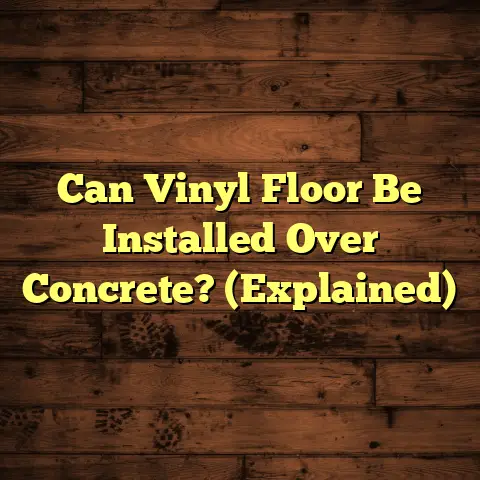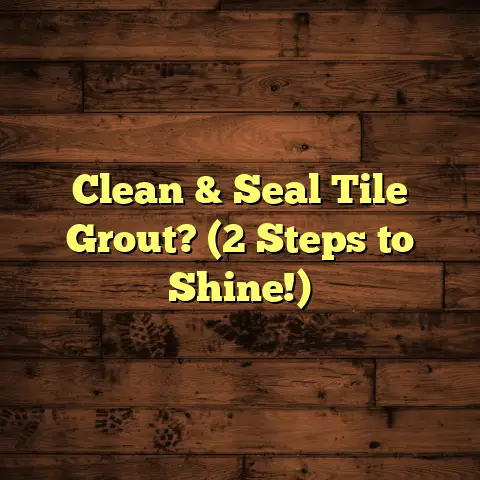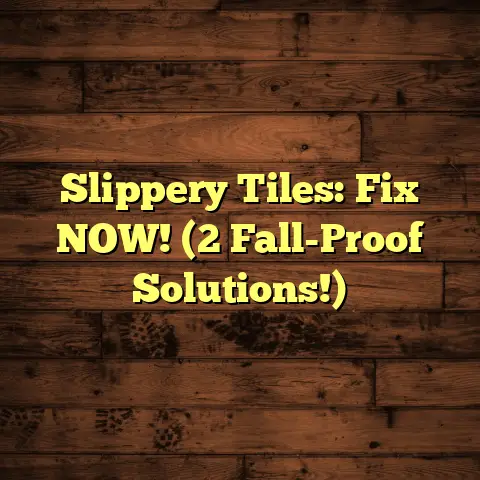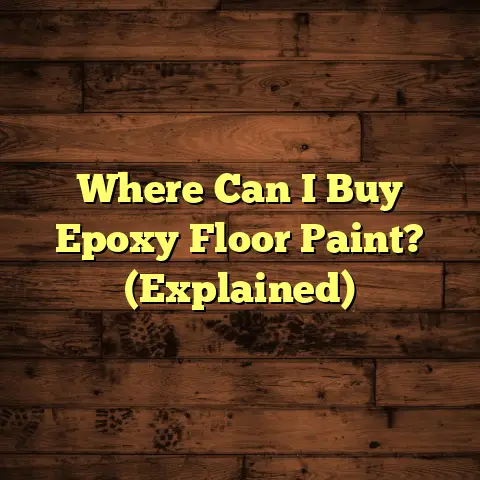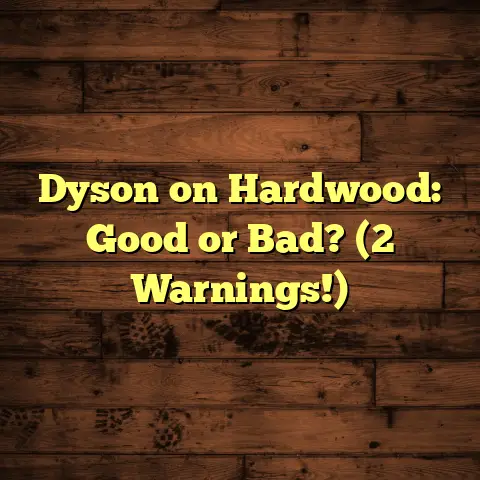Wax Paper Under Hardwood: Why? (1 Pro Tip Inside!)
I know, I know, it sounds like something your grandma used for baking, but trust me, this humble material has a place in the world of flooring too.
As a flooring contractor with years under my belt, I’m all about finding accessible solutions that make life easier for homeowners, DIYers, and even us pros.
So, let’s dive into why you might want to consider using wax paper under your hardwood floor, and I’ll even share a pro tip that can make all the difference.
Section 1: Understanding Hardwood Flooring
Hardwood flooring is a classic for a reason.
It’s beautiful, durable, and can add real value to
your home.
We’re talking about materials like:
- Oak: A popular choice, known for its durability and versatility.
- Maple: A lighter-toned wood with a smooth, modern look.
- Hickory: A very hard and durable wood with a distinct grain pattern.
- Walnut: A rich, dark wood that adds a touch of elegance.
And many more. Each with its own unique character and properties.
Now, the installation process is crucial. It usually involves these steps:
- Subfloor Prep: Making sure the subfloor is clean, level, and dry.
- Underlayment: Adding a layer of material between the subfloor and the hardwood.
- Acclimation: Allowing the hardwood to adjust to the room’s temperature and humidity.
- Installation: Nailing, gluing, or clicking the hardwood planks into place.
The underlayment is key.
It can provide moisture
protection, sound dampening, and a smooth surface
for the hardwood.
But here’s the thing: even with the best installation, hardwood floors can face issues like:
- Moisture Problems: Warping, cupping, or buckling due to excessive moisture.
- Squeaking: Annoying noises caused by friction between the subfloor and the hardwood.
- Movement: Expansion and contraction due to changes in temperature and humidity.
That’s where wax paper comes in.
Proper preparation
before installation is the key to preventing these
issues, and wax paper can be a surprisingly
effective tool.
Section 2: The Role of Wax Paper in Flooring
So, what exactly is wax paper?
It’s basically paper
that’s been coated with wax, making it moisture
resistant.
It’s different from:
- Parchment Paper: Which is heat-resistant and non-stick, often used for baking.
- Construction Paper: Which is thicker and designed for crafts.
- Plastic Sheeting: Which is waterproof but doesn’t allow for breathability.
Wax paper is a thin, inexpensive material that can act as a barrier against moisture and reduce friction.
Now, why would anyone consider using it under
hardwood flooring?
Well, some installers and
homeowners believe it can:
- Protect Against Moisture: By preventing moisture from the subfloor from reaching the hardwood.
- Reduce Squeaking: By minimizing friction between the subfloor and the hardwood planks.
- Allow for Movement: By providing a slip sheet that allows the hardwood to expand and contract without binding.
Let me give you some examples of situations where wax paper can be effective:
- Basements: Where moisture is often a concern.
- Over Concrete Subfloors: Which can wick up moisture.
- In Humid Climates: Where moisture levels are consistently high.
I’ve seen it work wonders in older homes where the
subfloor isn’t perfectly level or sealed.
It’s a
simple, affordable way to add an extra layer of
protection.
Section 3: Benefits of Using Wax Paper Under Hardwood
Okay, let’s get into the nitty-gritty of the benefits.
Here’s a detailed look at why wax paper can be a
smart choice:
Moisture Protection
This is probably the biggest reason why people use
wax paper.
It acts as a vapor retarder, slowing
down the transmission of moisture from the subfloor
to the hardwood.
Think of it like this: your subfloor might have some residual moisture, especially if it’s concrete.
Without a barrier, that moisture can slowly seep into
the hardwood, causing it to warp, cup, or even rot
over time.
Wax paper helps prevent that by creating
a protective layer.
Now, it’s not a waterproof barrier, so it’s not a
substitute for proper waterproofing in areas with
serious moisture issues.
But it can definitely help
in situations where moisture is a concern.
Sound Dampening
Here’s something you might not have considered: wax
paper can actually help reduce noise transmission.
It’s not going to be as effective as a dedicated
soundproofing underlayment, but it can make a
noticeable difference.
The wax paper helps to absorb some of the vibrations
that cause noise.
This can be especially helpful in
apartments or homes with multiple stories.
I’ve had clients tell me that they noticed a
reduction in noise after installing wax paper under
their hardwood floors.
It’s a small thing, but it
can definitely improve the acoustic comfort of your
home.
Squeak Reduction
Ah, the dreaded squeak!
It’s one of the most
annoying things about hardwood floors.
Squeaks are
usually caused by friction between the subfloor and
the hardwood planks.
Wax paper can help minimize that friction.
It acts as
a slip sheet, allowing the planks to move slightly
without rubbing directly against the subfloor.
I’ve used wax paper to fix squeaky floors in older
homes where the subfloor was uneven or had minor
imperfections.
It’s a simple and effective way to
silence those annoying noises.
Ease of Installation
This is a big one, especially for DIYers.
Wax paper
is incredibly easy to work with.
You simply roll it
out over the subfloor and overlap the edges.
No special tools or skills are required.
It’s a
quick and straightforward process that can save you
time and effort.
I’ve taught many homeowners how to install wax paper
under their hardwood floors.
It’s something that
anyone can do, regardless of their experience level.
Real-Life Examples and Testimonials
I’ve seen wax paper work wonders in countless
situations.
For example, I had a client with a
basement apartment that was prone to moisture.
We installed wax paper under the hardwood floors, and
it made a huge difference.
The floors stayed dry and
stable, and the client was thrilled with the results.
I also had a client with an older home that had
squeaky floors throughout.
We used wax paper to
address the squeaks, and it worked like a charm.
The
client couldn’t believe how quiet the floors were
afterward.
Section 4: The One Pro Tip
Alright, here’s the pro tip I promised you:
Overlap the wax paper seams by at least 6 inches.
Why?
Because that overlap ensures that moisture
can’t easily sneak through the cracks.
Think of it
like shingles on a roof – you want to make sure that
water can’t get underneath.
I’ve seen so many installations where people just
butted the wax paper edges together.
That’s a recipe
for disaster.
Moisture will find its way through those
tiny gaps, and you’ll end up with problems down the
road.
By overlapping the seams, you create a much more
effective moisture barrier.
It’s a simple thing, but
it can make a huge difference in the long run.
This tip comes from years of experience.
I learned it
from an old-school flooring contractor who taught me
the importance of attention to detail.
He always said,
“It’s the little things that make the difference.”
Section 5: Potential Drawbacks of Wax Paper
Now, let’s be real.
Wax paper isn’t a perfect
solution for every situation.
There are some
limitations and potential concerns to consider:
- Not a Waterproof Barrier: As I mentioned
earlier, wax paper is a vapor retarder, not a
waterproof barrier.
If you have serious moisture issues, you’ll need a more robust solution. - Not Suitable for All Types of Hardwood: Wax paper may not be the best choice for certain types of hardwood, such as bamboo or engineered hardwood, which may require specific underlayments.
- Can Tear Easily: Wax paper is relatively thin
and can tear easily, especially during
installation.
You’ll need to be careful when handling it.
I wouldn’t recommend using wax paper in areas with
high moisture levels, such as bathrooms or laundry
rooms.
In those situations, you’ll need a waterproof
membrane.
Also, if you’re installing a high-end hardwood floor, you might want to consider a more specialized underlayment that offers better sound dampening and insulation.
It’s all about weighing the pros and cons and making the best decision for your specific situation.
Section 6: Conclusion
So, there you have it – the lowdown on using wax
paper under hardwood flooring.
It’s a simple,
affordable, and accessible solution that can provide
moisture protection, sound dampening, and squeak
reduction.
I’ve seen it work wonders in countless situations, and I believe it’s a valuable tool for homeowners, DIYers, and professionals alike.
Just remember to overlap those seams by at least 6
inches!
That’s the pro tip that will make all the
difference.
Ultimately, the decision of whether or not to use wax
paper is up to you.
But I encourage you to consider
it as an option for your hardwood flooring needs.
Call to Action
Now, I want to hear from you!
Have you ever used wax
paper under hardwood flooring?
What was your
experience?
Share your thoughts and tips in the
comments below.
And if you’re not sure whether wax paper is right for
your specific situation, I encourage you to do some
more research and connect with a flooring
professional.
They can help you assess your needs and
make the best decision for your home.
Thanks for reading, and happy flooring!
